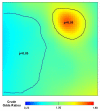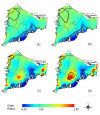Method for mapping population-based case-control studies: an application using generalized additive models
- PMID: 16764727
- PMCID: PMC1526437
- DOI: 10.1186/1476-072X-5-26
Method for mapping population-based case-control studies: an application using generalized additive models
Abstract
Background: Mapping spatial distributions of disease occurrence and risk can serve as a useful tool for identifying exposures of public health concern. Disease registry data are often mapped by town or county of diagnosis and contain limited data on covariates. These maps often possess poor spatial resolution, the potential for spatial confounding, and the inability to consider latency. Population-based case-control studies can provide detailed information on residential history and covariates.
Results: Generalized additive models (GAMs) provide a useful framework for mapping point-based epidemiologic data. Smoothing on location while controlling for covariates produces adjusted maps. We generate maps of odds ratios using the entire study area as a reference. We smooth using a locally weighted regression smoother (loess), a method that combines the advantages of nearest neighbor and kernel methods. We choose an optimal degree of smoothing by minimizing Akaike's Information Criterion. We use a deviance-based test to assess the overall importance of location in the model and pointwise permutation tests to locate regions of significantly increased or decreased risk. The method is illustrated with synthetic data and data from a population-based case-control study, using S-Plus and ArcView software.
Conclusion: Our goal is to develop practical methods for mapping population-based case-control and cohort studies. The method described here performs well for our synthetic data, reproducing important features of the data and adequately controlling the covariate. When applied to the population-based case-control data set, the method suggests spatial confounding and identifies statistically significant areas of increased and decreased odds ratios.
Figures








References
-
- Blot WJ, Fraumeni JF., Jr Geographic patterns of lung cancer: Industrial correlations. American Journal of Epidemiology. 1976;103:539–550. - PubMed
-
- Polissar L. The effect of migration on comparison of disease rates in geographic studies in the United States. American Journal of Epidemiology. 1980;111:175–182. - PubMed
-
- Monmonier M. Cartographies of Danger: Mapping Hazards in America. University of Chicago Press: Chicago; 1997.
-
- Rothman K, Greenland S. Modern Epidemiology. 2. Lippincott-Raven: Philadelphia; 1998.
-
- Hastie TJ, Tibshirani RJ. Generalized Additive Models. Chapman and Hall: London; 1990.
Publication types
MeSH terms
Grants and funding
LinkOut - more resources
Full Text Sources

